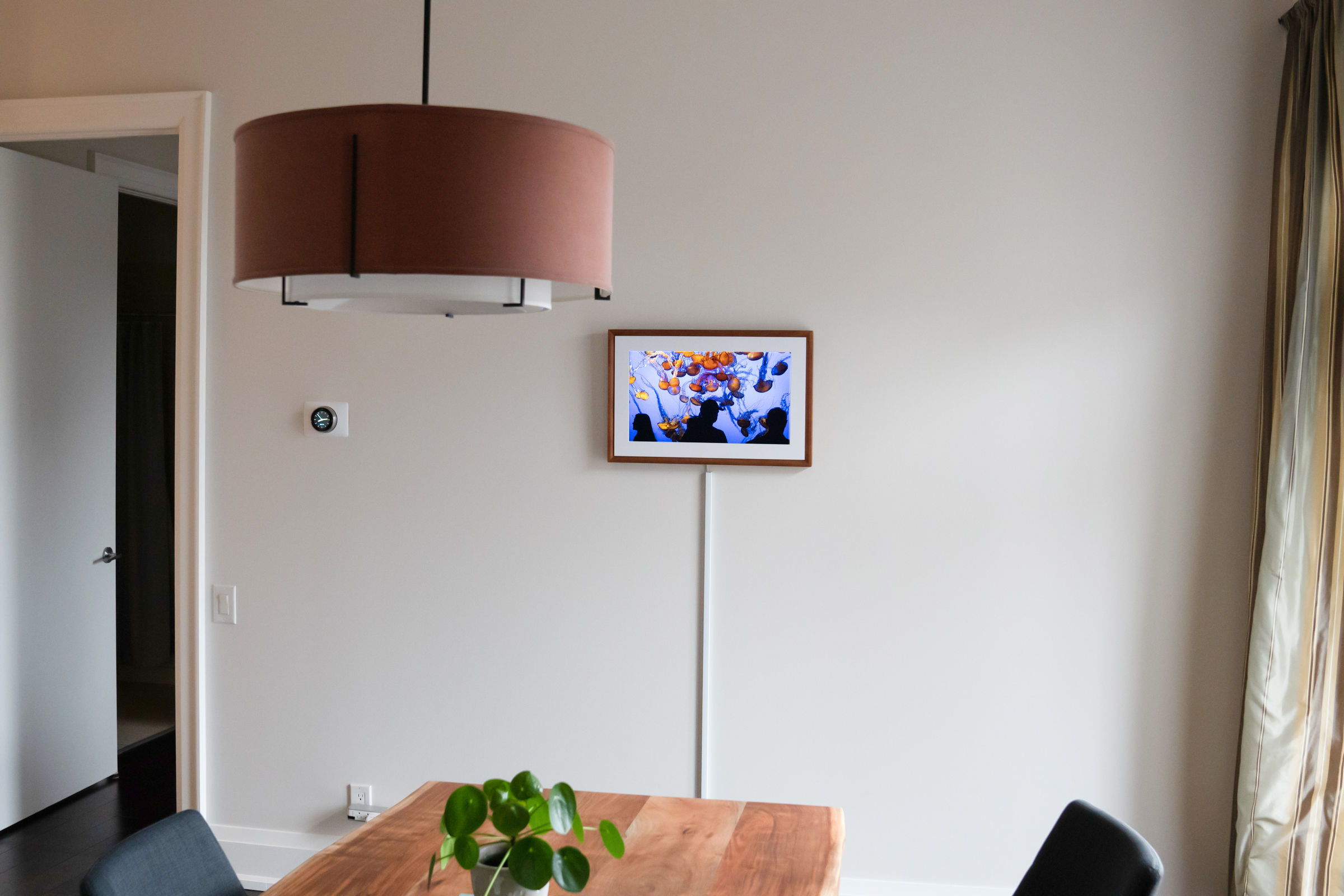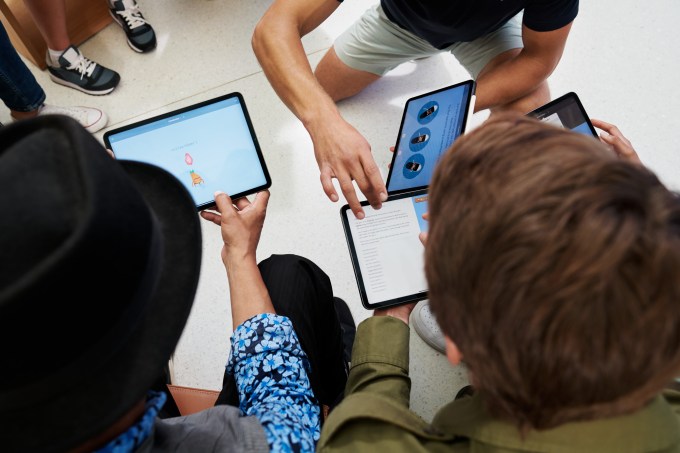Netgear has released the first updated Canvas digital art from from Meural since acquiring the company last September, and the next-generation connected frame comes with some decent quality-of-life improvements as well as a new, additional size. It’s not a dramatic change from the original Meural Canvas, but it means that a product that was already great is now even better.
The Meural Canvas II from Netgear comes in two sizes, including a smaller 16×24-inch frame that provides a 21.5-inch diagonal picture (starting at $399.95), and a 19×29-inch frame with a 27-inch diagonal display (starting at $599.95). Both screens are 1080P full HD resolution, and both feature ambient light sensors (which are relocated to a better location under the mat that surrounds the screen for improved light detection) that will automatically adjust the brightness of your image to make it appear more natural and less like a screen.
The Canvas II features built-in Wi-Fi, which is also upgraded with this generation (Netgear, which makes routers and other Wi-Fi products, seems to have brought its expertise to bear here) and they offer new Ethernet connectivity, as well as full-size SD ports. They also can hang either vertically or horizontally, and a new accessory mount for this generation (sold separately) allows for even easier switching between the two orientations via simple rotation.
 For the virtual art collector
For the virtual art collector
Meural is controlled primarily from the Meural companion app, though you can also access a web interface to accomplish much of the same thing from a desktop browser. The app features curated collections of artwork, which is available both via a paid monthly subscription and via direct, one-time purchases. One of the changes that the Meural service has undergone is that the subscription membership now gets you some, but not all, of the art available — some premium content is still an additional charge. It’s definitely not as good from the user’s perspective as when everything was free once you’d paid the subscription fee, but paying monthly still nets you 20GB of cloud storage for uploading your own art, discounts on the stuff that is available for purchase and access to a much larger library than you get without any membership.
Subscriptions go for either $8.95 per month, or $69.95 per year, and they’re probably plenty to satisfy most casual art lovers who just want some recognizable or interesting works to adorn their walls, and want to be able to change that on a fairly regular basis. And when you use the art provided through Meural’s various collections, you can take a look at credits and descriptions right on the display — available quickly via a motion control swipe up gesture made possibly by the sensors built into the frame.
 A note on those motion controls — they allow you to navigate between artwork, and even change playlists and access a menu of other options related to the frame. Basically, you wave your hand near the bottom of the Meural to make this work, and it’s great when it does work, but it definitely takes some learning to figure out how and where to swipe to make it reliably respond. It’s convenient that it’s an option, but controlling the display with the iOS or Android app is a lot more pleasant, generally speaking.
A note on those motion controls — they allow you to navigate between artwork, and even change playlists and access a menu of other options related to the frame. Basically, you wave your hand near the bottom of the Meural to make this work, and it’s great when it does work, but it definitely takes some learning to figure out how and where to swipe to make it reliably respond. It’s convenient that it’s an option, but controlling the display with the iOS or Android app is a lot more pleasant, generally speaking.
The built-in library that Meural provides is definitely a selling point, and Meural is regularly adding new art collections, both for paid purchases and to build out the library of those works available included in the subscription. It just added a bunch through a new partnership with Marvel, in fact, including movie posters from a long list of their cinematic universe releases.
For the amateur/enthusiast/pro photographer
The primary reason I think the Meural Canvas II is a fantastic product has very little to do with its subscription-based art collection, however. Instead, it’s all about the flexibility and convenience that the Canvas provides when it comes to displaying your own photos. It’s incredibly easy to upload your photos from your mobile device or your desktop, and you can organize them in playlists, add descriptions and titles, and crop them manually or have the frame crop them automatically to display in its 16×9 aspect ratio.
 As a display for your own photos, the Meural Canvas II is hard to beat: It’s a lot more flexible and cost effective than getting high-quality prints made, as you can rotate them out as often as you feel like, and the display’s color rendering and matte finish, while obviously not as good as a professional photo print, is nonetheless very pleasing to the eye. When you take as many photos as we collectively do now, but seldom have anywhere to show them off, the Canvas provides the perfect opportunity to ensure they have a great place to shine at home.
As a display for your own photos, the Meural Canvas II is hard to beat: It’s a lot more flexible and cost effective than getting high-quality prints made, as you can rotate them out as often as you feel like, and the display’s color rendering and matte finish, while obviously not as good as a professional photo print, is nonetheless very pleasing to the eye. When you take as many photos as we collectively do now, but seldom have anywhere to show them off, the Canvas provides the perfect opportunity to ensure they have a great place to shine at home.
The included SD card reader means it’s easy to load up images and put them on the Canvas locally, but I also found that uploading from whatever Wi-Fi-connected device I had access to around the house was easy and fast (again, seems like Netgear’s core expertise came into play here). The ability to quickly change the orientation, which is fast and simple even without the rotation mount accessory, is another big plus for your own photos, as it means you can show off both portraits and landscapes.
Oh, and the ability to load your own artwork isn’t limited to just your photography, of course — any image in a standard format, including animated GIFs, can work on the Meural, which means it’s really only limited by the scope of what’s available on the internet.
Bottom line
 Between the frame options, which you can swap out for different color options eventually when they’re sold separately, and the ability to upload your own content to the Canvas, it’s easily the most customizable piece of home decor you can find right now. For some, opting to move up to something like Samsung’s The Frame TV might be a better option, but that’s much larger, much more expensive, much heavier for mounting and not as flexible when it comes to playlists and your own curation of art to display.
Between the frame options, which you can swap out for different color options eventually when they’re sold separately, and the ability to upload your own content to the Canvas, it’s easily the most customizable piece of home decor you can find right now. For some, opting to move up to something like Samsung’s The Frame TV might be a better option, but that’s much larger, much more expensive, much heavier for mounting and not as flexible when it comes to playlists and your own curation of art to display.
The Meural Canvas II provides largely the same visual experience as the generation it replaces, but the other improvements make this a much better product overall, with faster, more reliable Wi-Fi connectivity, improved motion controls, more flexible on-device storage and new mounting options. If you like some variety in your wall art, or you’ve just been trying to figure out how to do something interesting with all those pictures you take, the Meural Canvas II is a great option.

from Android – TechCrunch https://ift.tt/2O9DIw4
via
IFTTT






